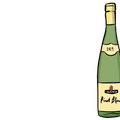

Chardonnay - the world's most popular white variety. With oak or without, it is a star in any language
TL; DR
Chardonnay - the world's most popular white variety. With oak or without, it is a star in any language
So, what is Chardonnay all about?--red
Chardonnay is best known for full-bodied white wines that have been aged in oak, but also produces stunning wines without oak. It has full flavours mixed with vibrant acidity, making it versatile at the dining table and sure to impress.

Where does Chardonnay come from?--aromatic
There is a small township in the southern Burgundy subregion of the Mâconnais called Chardonnay! Previously known as Cardonnacum, this is recognised as the original home of the grape.
Burgundy is definitely the best-known region for this great grape, but other countries also produce amazing examples. International critics agree that our own backyard should be in every conversation for fine Chardonnay, along with California, Argentina, South Africa and Chile.
Who's famous for Chardonnay?--racy
Chardonnay is a global superstar, with each famous region adding its own signature style influenced by climate and terroir.

France:
- Chablis: Cool climate, producing lean, steely wines with high acidity and distinct mineral notes.
- Burgundy: Ranges from mineral-driven Chablis to richer, oak-aged wines with apple, pear, and a hint of butter.
Australia:
- Yarra Valley: Elegant wines with bright acidity and citrus flavours.
- Margaret River: Fuller-bodied Chardonnays with tropical fruit notes and a touch of oak.
USA:
- Napa Valley: Rich, buttery Chardonnays with ripe tropical fruit and generous oak.
- Santa Barbara: Balanced Chardonnays with crisp acidity and green apple and lemon flavours.
Argentina:
- Mendoza: Fresh, vibrant Chardonnays with crisp acidity and stone fruit flavours, often unoaked.
South Africa:
- Stellenbosch: Rich, full-bodied wines with tropical fruit and a hint of oak.
- Hemel-en-Aarde: Refined Chardonnays with bright acidity and minerality.
What does Chardonnay taste like?--aromatic
Chardonnay is a chameleon in the wine world, offering a wide range of flavours influenced by its origin and winemaking techniques.
Chablis is known for high acidity and flinty, mineral-driven notes, with green apple and lemon. Burgundy showcases melon, white peach, and lemon with hints of almond and spices, often with oak influence.
New World Chardonnays, like those from Australia and the USA, feature ripe peach, apricot, and tropical fruits, with notes of hazelnut, butter, and vanilla from oak aging and lees stirring.
Winemaking techniques shape Chardonnay's profile. Neutral oak adds texture, light oak adds subtle vanilla and spice, while heavy oak aging brings butter, toast, and caramel. Lees stirring enhances creaminess and complexity with nutty or yeasty qualities.
Whether you prefer the crisp, mineral flavours of Chablis or the lush, buttery notes of Napa Valley, Chardonnay offers a wide spectrum of tasting experiences reflecting its terroir and winemaking style.

Main styles Chardonnay is known for?--cellar
Chardonnay is easily categorized by oak use and climate.
- No or Low Oak: These wines showcase clean fruit flavours, emphasizing the grape's natural profile.
- Some Oak: Adds texture, complexity, and subtle vanilla or spice notes, enhancing the wine's depth.
- Lots of Oak: Produces rich, round, and full-bodied styles with generous toast, nuts, spices and sometimes coconut flavours.
Fruit flavours are mainly influenced by the climate. Cooler regions deliver zesty citrus and green apple notes, while warmer regions offer tropical flavours like pineapple and banana.

What foods does Chardonnay pair with?--plum
Chardonnay is versatile, making it an excellent companion for a variety of dishes, depending on its style.
- Unoaked Chardonnay: With its clean fruit flavours and bright acidity, unoaked Chardonnay pairs beautifully with lighter fare. It shines with fish and seafood, such as grilled shrimp, oysters, and delicate white fish. The crispness also complements fresh salads and vegetable dishes, enhancing their natural flavours.
- Lightly Oaked Chardonnay: The added texture and subtle vanilla or spice notes of lightly oaked Chardonnay make it a great match for poultry and richer fish. Try it with roast chicken, turkey, or salmon. It also pairs well with creamy pasta dishes and soft cheeses, such as Brie or Camembert, where the wine's complexity can enhance the food's richness.
- Fully Oaked Chardonnay: The rich, round, and full-bodied nature of fully oaked Chardonnay, with its flavours of toast, nuts, and butter, is ideal for heartier dishes. This style can handle roasted pork, veal, and even dishes with a bit of smokiness, like BBQ corn on the cob. It also pairs wonderfully with richer fish like tuna or swordfish, as well as creamy sauces and aged cheeses.

Fun fact--earth
Did you know that Chardonnay is not just a superstar on its own but also one of the key players in the world of sparkling wines? In the Champagne region of France, Chardonnay is one of the three main grapes used to produce the world's most famous bubbly! Its crisp, elegant flavours contribute to the finesse and longevity of Champagne, making it a true sparkling sensation.
If you like this, you should also give these grapes a guzzle...--wines
Do you know your wine personality? If your answer is no, take our quiz to find out which wines to pick up next and build your box!
Build my box





